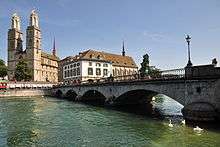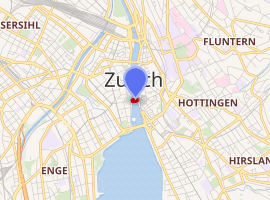Münsterbrücke, Zürich
Münsterbrücke is a pedestrian and road bridge over the Limmat in the city of Zürich, Switzerland. It is listed in the Swiss inventory of cultural property of national and regional significance. It is indirectly named after two Münster (minsters), the Fraumünster and Grossmünster.
Münsterbrücke | |
|---|---|
 | |
| Coordinates | 47°22′12″N 8°32′35″E |
| Carries | Two lanes for road traffic and pedestrians |
| Crosses | Limmat |
| Locale | Zürich, Switzerland |
| Official name | Münsterbrücke |
| Owner | City of Zurich |
| Maintained by | City of Zurich |
| Preceded by | Quaibrücke |
| Followed by | Rathausbrücke |
| Characteristics | |
| Material | Stone |
| No. of spans | 4 |
| History | |
| Designer | Alois Negrelli |
| Engineering design by | Conrad Stadler, Johann Jakob Locher-Oeri |
| Constructed by | Heinrich Staub (Steinmetzmeister) |
| Construction start | 1836 |
| Opened | 1838 |
| Replaces | Obere Brücke (wooden, pedestrian bridge) |

| |
_-_linkes_Limmatufer_-_M%C3%BCnsterbr%C3%BCcke_2013-04-08_15-19-43.jpg)

Geography
Münsterbrücke crosses the Limmat, connecting Münsterhof and Limmatquai at the historical core of the medieval town of Zürich. It is the second bridge over the Limmat, below the Quaibrücke and above the Rathausbrücke.
Transportation
The Zürich tram lines 2, 4 and 15 run past it on the Limmatquai. The ZSG Zürichsee-Schifffahrtsgesellschaft and its Limmat tour boats pass under it. Individual transportation is limited to road transport use between upper Limmatquai (Bellevueplatz), upstream of the Limmat, and Münsterhof, since the area is part of the pedestrian zone of Zürich.
Architecture
In 1835, the chief engineer of the merchant society of the city of Zürich, Alois Negrelli, initiated the construction of the bridge[1] in collaboration with the master-builders Conrad Stadler and Johann Jakob Locher-Oeri,[2] who engineered the sophisticated wooden scaffold. The foundations of the bridge were based on 472 oak piles with a length of up to 15.6 m (51 ft), to bear its weight of about 6,100 tons. The foundation was filled with concrete, and the spaces between the piles were reinforced with rubblestones. Above that, cofferdams and caissons were erected and reinforced by sandstone plates that lay on cement mortar. The structure consists of four flat arches with a 15 m (49 ft) inside diameter and a height of 2.1 m (6 ft 11 in) above the Limmat level, and a fifth arch of 9.9 m (32 ft) above a former channel into the former Kornhaus building opposite the Fraumünster church. The pillars between the arches have a diameter of 2.4 m (7 ft 10 in) and are protected by a layer of cement and paneled with black Jura marble. The pillars and cornices and the stones of the traffic lane are made of St. Gotthard granite. The cast-iron railings were produced in the Grand Duchy of Baden.[3]
The present bridge has two lanes and sidewalks on both sides, but it is commonly used as a pedestrian and bicycle bridge as road transport is limited between Limmatquai and Münsterhof.[4]
- One of the bridge's supports
- Cast-iron railings
- Traffic lane made of St. Gotthard granite.
- View from Stadthausquai looking downstream
The Hans Waldmann (1435–1489) equestrian monument in front of the Fraumünster church was unveiled by the Kämbel guild on 6 April 1937 at the site of the former Fraumünster Kornhaus (granary), which was torn down in 1897, above the fifth arch of the bridge.[5]
History
The earliest bridge at the location was built in the Roman era, and in medieval Zürich a wooden bridge, called the Obere Brücke (upper bridge), connected the two banks of the Limmat. Between 1836 and 1838, the former wooden bridge was replaced by a stone bridge. Alois Negrelli engineered and supervised the construction of the bridge as it is still present today;[6] it was inaugurated in August 1838.[7][8] The bridge congested the traffic on the Limmat, so a land connection in the then "modern" Zürich was urgently needed by replacing the narrow medieval Reichsstrasse towards the present Rathausbrücke crossing. Thus, sections of the present Limmatquai on the eastern shore of the Limmat were built simultaneously.
Starting in 1861, the Fraumünster granary temporarily housed in one of its numerous empty rooms the Betraum of the Jewish citizens of Zürich until the Synagoge Zürich Löwenstrasse was built in 1881.[9] Until May 1901 and between 1910 and 1924 there was even a tramway crossing the bridge towards Paradeplatz. The original construction has been repaired several times, most recently in the late 1990s.
Cultural heritage of national importance
Münsterbrücke is listed in the Swiss inventory of cultural property of national and regional significance as a Class A object of national importance.[10]
References
- "Aufzeichnungen und Briefe von und an Ingenieur Alois [Luigi] Negrelli (1799-1858)", ARCHIVKATALOG (in German), Zurich, Switzerland: Staatsarchiv des Kantons Zürich, 2003 [written between 1832-1839], X 52.2, retrieved 2015-09-19
- "Dem hiesigen Baumeister, Herrn Conrad Stadler, wird eine Empfehlung pro justitia an die Regierung von Schwytz ertheilt, bezüglich auf seinen Streit mit der Gemeinde Galgenen wegen der Abrechnung über dortigen Kirchenbau." (PDF), ARCHIVKATALOG (in German), Zurich, Switzerland: Staatsarchiv des Kantons Zürich, 10 November 1827, MM 1.100 RRB 1827/0854, retrieved 2015-09-19
- Alois Negrelli (1 January 2016) [1839], "Die neu Münsterbrücke über die Limmat: Bericht des Ober-Ingenieurs Herrn Negrelli an die Brückenbau-Komission", Zeitschrift über das gesamte Bauwesen (in German), 3 (6), doi:10.5169/seals-5548
- "Limmatquai" (in German). Zurich, Switzerland: Stadt Zürich. Retrieved 2015-01-06.
- Staatsarchiv des Kantons Zürich, ed. (13 September 2000). Kleine Zürcher Verfassungsgeschichte 1218–2000 (PDF) (in German). Zurich, Switzerland: Chronos Verlag. ISBN 3-905314-03-7. Retrieved 2014-12-20.
- Gebrüder Dürst. "Der Bürkliplatz" (in German). alt-zueri.ch. Retrieved 2015-01-07.
- "Die Commißion für Einweihung der Münsterbrücke verdankt den erhaltenen Beytrag" (PDF), ARCHIVKATALOG (in German), Zurich, Switzerland: Staatsarchiv des Kantons Zürich, 23 August 1838, MM 2.44 RRB 1838/1509, retrieved 2015-09-19
- "Berichtigung der Kostennote über die Illumination des Rathhauses und der Hauptwache bey Anlaß der Einweihung der Münsterbrücke." (PDF), ARCHIVKATALOG (in German), Zurich, Switzerland: Staatsarchiv des Kantons Zürich, 14 September 1838, MM 2.44 RRB 1838/1620, retrieved 2015-09-19
- "Zürich (Kanton Zürich, Schweiz) Jüdische Geschichte in Zürich - Die Israelitische Cultusgemeinde Zürich (ICZ) und ihre Synagoge in der Löwenstraße" (in German). Alemannia Judaica - Arbeitsgemeinschaft für die Erforschung der Geschichte der Juden im süddeutschen und angrenzenden Raum. 2003. Retrieved 2015-01-25.
- "Schweizerisches Inventar der Kulturgüter von nationaler Bedeutung, ISOS=Stadt Zürich" (PDF), ISOS (in German), Schweizerische Eidgenossenschaft, Amt für Bevölkerungsschutz, 1 January 2016, archived from the original (PDF) on 1 October 2015, retrieved 2016-01-01
External links
| Wikimedia Commons has media related to Münsterbrücke Zürich. |